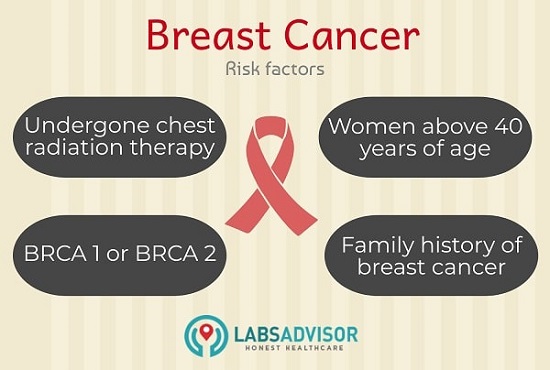
Mammography is a medical procedure that uses a low-energy X-ray to take an image of the human breast. This X-ray image is called a mammogram.
Book your Mammography test at your local top-quality labs through us at up to 50% discount. The lowest Mammography test cost is ₹680 only.
Mammography Test Through LabsAdvisor
|
Book your Mammography test online yourself at any time of the day or night by clicking on the appropriate link in the table below.
Mammography Test Cost in India and Lab Details
We offer the Mammography test in over 20 Indian cities. Click on the link of your city below to choose a lab and make an online booking for home collection at a suitable time.
| City for Mammography Test (Both Breast) | Prices Starting From |
| Mammography Test Cost in Delhi (Both Breast) | ₹1540 |
| Mammography Test Cost in Bangalore (Both Breast) | ₹1360 |
| Mammography Test Cost in Mumbai (Both Breast) | ₹1600 |
| Mammography Test Cost in Hyderabad (Both Breast) | ₹800 |
| Mammography Test Cost in Chennai (Both Breast) | ₹2565 |
| Mammography Test Cost in Gurgaon (Both Breast) | ₹1800 |
| Mammography Cost in Other Cities (Both Breast) | ₹800 |
If your city is not listed in the table above, call us on +918061970525. We will get back to you with the cost of the Mammography test at your location.
Get the lowest Mammogram cost test by calling us at
If you want us to call you back, click on the link below
The discounts on Mammogram test costs are available only to those who made the booking through LabsAdvisor.com. You will be asked to pay the actual Mammography price if you do not carry the booking confirmation message sent by the LabsAdvisor.com
What is a Mammography or Mammogram?
Mammography is a medical procedure that uses a low-energy X-ray to take an image of the human breast. This X-ray image is called a mammogram. Mammography is of two types
- Screening Mammography: This procedure is used to check for breast cancer in women who show no symptoms of the disease. It usually involves taking two x-ray pictures of each breast. The X-ray image can show tumors that cannot be felt. Screening mammograms can also find micro-calcification (small deposits of calcium) which may be an indication of breast cancer.
- Diagnostic Mammography: This mammography is done on patients to check for breast cancer after a lump or other sign or symptom of breast cancer is found. Symptoms include pain in the breast, change in shape or size of the breast, thickening or pigmentation of the skin of the breast, or nipple discharge. A diagnostic mammogram can also be done to evaluate the abnormality seen in screening mammograms. It is also done on patients with breast implants, breast reductions, or with a family history of breast cancer. Diagnostic mammography takes longer than screening mammography as more x-rays are needed from different angles to ascertain the disease. A magnified picture of the suspicious area is taken for the doctor to make an accurate diagnosis.
Why is Mammography Done?

- Women from ages 40 to 54 should get screening mammograms done annually. After 54 years of age, it can be done every 2 years
- Women with a family history of breast or ovarian cancer should have an annual mammogram from 35 years of age.
- Women who have received chest radiation therapy should also start getting annual mammography done as early as 30 years of age.
- Women who show the symptoms of breast cancer and their healthcare provider recommends a mammogram.
- Women who have a known BRCA1 or BRCA2 gene mutation.
What are the Symptoms of Breast Cancer?

Although breast screening or mammography should be a routine annual procedure for women age over 45, in some women with symptoms, an early test may be required. These symptoms are:
- A lump or thickened skin in either breast
- Change in size or shape of one or both breasts
- Discharge from either of nipples or nipples sinking in.
- Dimpling of the skin of the breasts
- A lump in either of armpits
What are the Benefits of the Mammography Test?
- A mammogram helps in the early detection of cancer. Early-stage cancers are 99% curable.
- A mammogram is able to detect micro-calcification, which are tiny deposits of calcium seen in the early stages of breast cancer.
- A mammogram uses a low dose of x-ray so is not harmful. The benefit of early detection far outweighs the small amount of radiation.
How Mammography is Performed?
During Mammography, the technician positions the breast in a mammography unit and then compresses it with a paddle. Although a little uncomfortable, compression is essential for a good mammogram. Usually, two views are taken for each breast hence four x-rays are obtained. Additional images may be taken if specified by the doctor.
A few precautions should be taken before going in for Mammography:
- Inform your doctor if you are or likely to be pregnant as radiation can be harmful to the fetus.
- It is best to undergo mammography within a week of your periods
- Inform your doctor if you are taking hormone replacement therapy
- Do not wear deodorant, talcum powder, or body lotion on your breast or under your arms on the day of the exam. The mammogram will be difficult to interpret and can give false positives for calcium deposits.
- Prior mammograms should be carried along so that doctor can compare with the present ones
How a Breast Ultrasound is Different From Mammography?
Ultrasound imaging of the breast uses sound waves to take pictures of the internal structures of the breast while Mammogram uses X-rays. Although ultrasound is less painful and does not use radiation, it is the second line of a diagnostic procedure.
Ultrasound is recommended when the doctor has found some abnormalities in mammograms or breast MRIs. It may also be useful in women with dense breast tissue. Ultrasound results in more false-positive as compared to Mammograms, therefore, doctors do not recommend it for regular screening.
What is Breast Cancer?
Cancer is an uncontrolled growth of abnormal cells. It can start in any part of the human body. Normally human cells grow and divide as and when the body needs them. The old and damaged cells die giving way to new cells. These new cells are formed by cell division, also called replication, as daughter cells are supposed to be perfect copies of the mother cells.
But sometimes there may be some errors in the cell division process called the mutation. The resultant daughter cells from such division are abnormal and are called cancerous cells. There is a built-in error control process in our bodies that leads to the self-destruction of these cancerous cells.
It is when this error control process of programmed cell death fails, the mutated abnormal cells survive and multiply. These cancer cells are also able to ignore the signals that normally tell them to stop replicating and hence may form growth called tumors.
As these tumors grow, some cells can break free and travel through the bloodstream to a distant part of the body forming new tumors.
Breast cancer occurs when cells in the breast begin to grow uncontrollably. The tumor formed from such growth can often be felt as a lump or detected through an x-ray. Breast cancer can start from any part of the breast.
Some breast cancers originate from the milk ducts and don’t develop the ability to spread outside the breast. Such breast cancers are non-invasive called carcinoma (DCIS). This form of cancer rarely shows as a lump and is usually found on a mammogram.
Invasive ductal cancer develops in the cell lining of the ducts and accounts for about 80% of all breast cancers. There are also other types of breast cancers that are less common. It is possible for breast cancer to spread to other parts of the body through the bloodstream or lymph nodes. It is known as metastatic cancer.
Breast cancer is the second most common type of cancer in women. Approximately 12.3 % of women develop breast cancer at some point during their lifetime. Women from developed countries show more chances of getting cancer but incidences in developing countries are also increasing rapidly.
Other topics you may be interested in:-
- CT Scan Cost in Bangalore
- HSG Scan Cost in India
- PET Scan Cost in Mumbai
- Ultrasound Level 2 Cost in India






